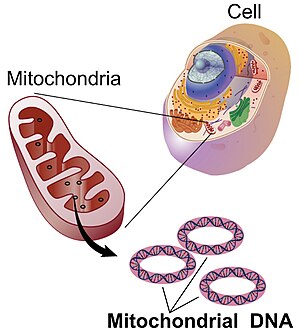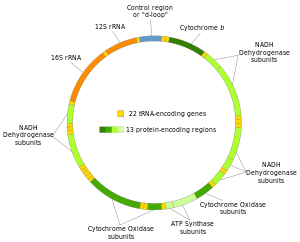Non-nuclear inheritance
The majority of DNA, and thus genetic information, is stored in the nucleus in eukaryotic cells. A group of genes whose DNA is located in the cytoplasm is called a plasmome. A small part (about 2%), however, is localized outside the nucleus, in some organelles:
- mitochondria
- chloroplasts
They can arise independently of the cell's reproductive cycle, but they cannot arise de novo. The laws of inheritance of conditional plasmids do not agree with Mendelian rules (so-called non-Mendelian inheritance).
Manifestations of extranuclear inheritance[edit | edit source]
The results of reciprocal crosses are not identical, extranuclear traits cannot be studied in connection with nuclear inheritance. The progeny of individuals hybrid for extranuclear genes split at rates that cannot be interpreted in accordance with knowledge about the splitting, combinability and interaction of genes located on nuclear chromosomes.
Evidence of extranuclear inheritance[edit | edit source]
The phenotype is not demonstrably controlled by core genes in some cases. Experimental nuclear swapping in cells will clearly demonstrate the proportion of nuclear and extranuclear inheritance. Transmission of characters without nuclear transmission is indicative of extranuclear inheritance. Extranuclearly driven traits more often show autosomal cleavage.
Plastid linked inheritance[edit | edit source]
Plastids are organelles typical of plant cells. They are separated from the cytoplasm by a semipermeable membrane. They arise by autoreproduction, division or from proplastids.
Mitochondrial linked inheritance[edit | edit source]
Mitochondrial inheritance, is encoded on mtDNA. This is very similar to prokaryotic DNA (circular chromosome, without introns,...). It is located in the matrix of mitochondria. It has no repair systems. Mitochondrial diseases are chronic and often of late onset.
Matroclinic inheritance[edit | edit source]
Mitrochodrial DNA is inherited exclusively from the mother, because when the egg is fertilized, the paternal mitochondria from the sperm are destroyed (damaged by the great power that the sperm needs to move). In exceptional cases, both maternal and paternal mitochondria can be found in the cytoplasm of an individual (they were not destroyed in the zygote). Such an individual is referred to as a cybrid (cytoplasmic hybrid, chimera).
The genes contained in the mtDNA molecule code for respiratory chain proteins, units of the ATPase complex, subunits of the NADH-dehydrogenase complex, two genes for ribosomal RNA-ase and 22 genes for transport RNA molecules. Chondrinogens, or genes bound to mitochondria, are inherited by so-called cytoplasmic inheritance.
Hereditary mitochondrial diseases[edit | edit source]
The molecular genetic basis of mitochondrial pathologies can be either deletions of a 5 kb region between the genes for ND5 (NADH-dehydrogenase subunit 5) ATPase 8 (ATPase subunit 8) or point mutations (mostly changing the sense of codon reading – missense or substitution).
- Kearns-Sayre syndrome — progressive external ophthalmoplegia, pigmentary degeneration of the retina, cardiac and cerebellar problems.
- Mitochondrial pathology caused by point mutations:
- LHON (Leber Hereditary Optic Neuropathy) — blindness in men under 25; the penetrance of the disease is 3-4 times higher in men than in women.
- MELAS (Mitochondria Myopathy, Encephalopathy, Lactic Acidosis, Stroke-like episodes) — the first symptoms appear between the 5th and 15th year of the individual's life, a single nucleotide substitution in the leucine tRNA gene (position 3243).
- MERF (Myoclonic Epilepsy with Ragged red Fibers) — manifestation 5.-12. year of an individual's life.
Links[edit | edit source]
References[edit | edit source]
- ŠTEFÁNEK, Jiří. Medicína, nemoci, studium na 1. LF UK [online]. [cit. 11. 2. 2010]. <https://www.stefajir.cz/>.



